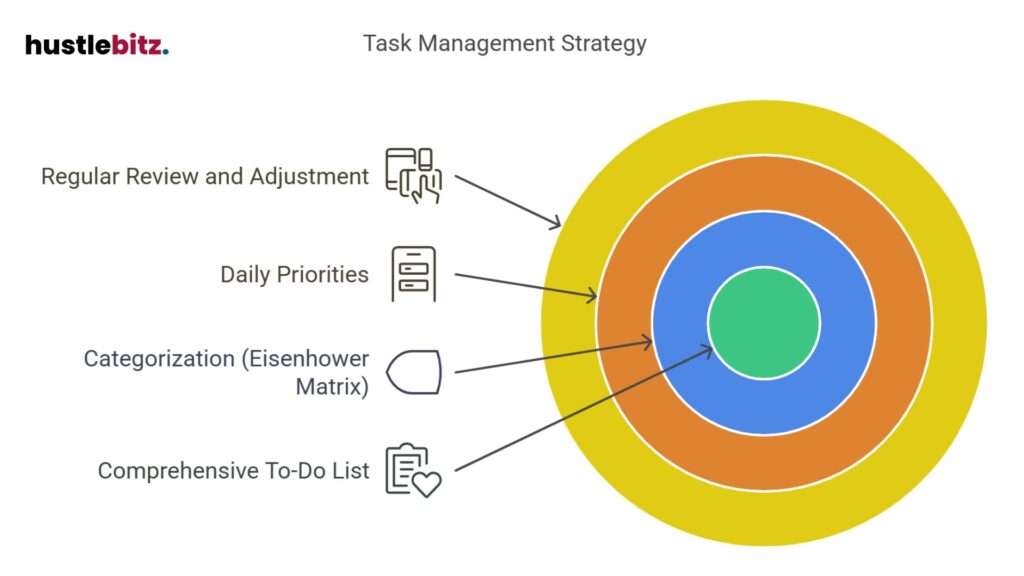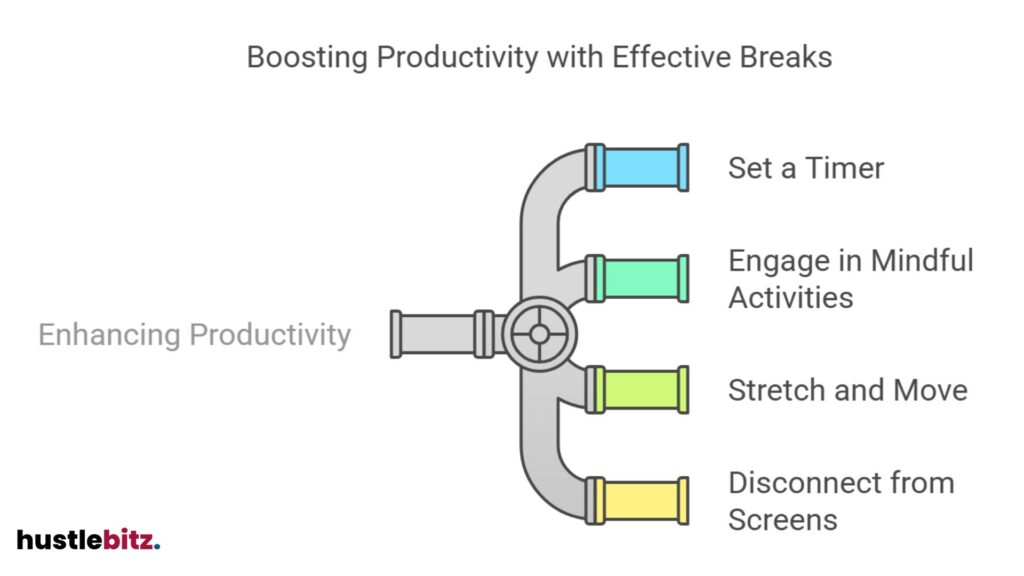To avoid burnout while staying productive, it is crucial to recognize its early signs, such as emotional exhaustion and irritability. Set realistic goals and prioritize tasks to manage workloads effectively. Implement time management techniques, like the Pomodoro Technique, to maintain focus while allowing for regular breaks. Creating work-home boundaries ensures mental separation, which aids in maintaining work-life balance. Incorporating mindfulness practices can enhance overall well-being. Staying physically active is also vital in combating stress. If needed, seeking professional support can provide tailored strategies for managing burnout and enhancing productivity. Discover more effective methods for achieving this balance.
Key Takeaways
- Recognize signs of burnout, such as emotional exhaustion and irritability, to address stress proactively.
- Set realistic goals and prioritize tasks to maintain focus and reduce overwhelm.
- Implement time management techniques, like the Pomodoro Technique, to structure work schedules effectively.
- Establish clear work-home boundaries to promote work-life balance and respect personal time.
- Incorporate mindfulness practices and regular physical activity to enhance resilience against stress and improve overall well-being.

Recognize the Signs of Burnout

Recognizing the signs of burnout is essential for maintaining both mental health and productivity in the workplace. Burnout often manifests through emotional exhaustion, a sense of detachment from work, and reduced efficacy. Individuals may experience fatigue, irritability, and a lack of motivation, which can hinder their ability to serve others effectively. Understanding these signs is crucial for anyone committed to fostering a supportive environment.
To safeguard mental and physical health, it is vital to monitor one’s emotional state and energy levels. Are you feeling overwhelmed by your responsibilities? Do you find yourself disengaged during interactions with colleagues or clients? These are common indicators of burnout that should not be overlooked. By recognizing these signs early, one can take proactive measures to reduce stress and restore a healthy work-life balance.
A harmonious balance between personal and professional life is key to staying productive and engaged. Simple practices such as setting boundaries, taking regular breaks, and seeking support can mitigate the risks of burnout. Engaging in self-care activities, whether through exercise, mindfulness, or hobbies, can rejuvenate the spirit and enhance resilience against workplace pressures.
Ultimately, fostering an environment that prioritizes mental well-being not only benefits individuals but also enhances the overall efficacy of teams. By acknowledging and addressing the signs of burnout, we can create a culture that values both productivity and the well-being of its members, ensuring that those who serve others do so with vigor and passion.
Set Realistic Goals

Setting realistic goals is essential for maintaining motivation and preventing burnout, as achievable objectives provide a clear roadmap for success while reducing feelings of overwhelm.
When we set realistic goals, we create a structured approach to our tasks that fosters a sense of accomplishment. This is particularly important in environments where serving others is a priority, as the pressure to meet high expectations can often lead to stress and fatigue.
To avoid burnout, it is crucial to establish goals that are not only attainable but also aligned with your values and responsibilities. By focusing on what is genuinely important, you can enhance your productivity at work while ensuring that your efforts contribute to the greater good. This alignment fosters a deeper connection to your work, making it easier to stay motivated.
Additionally, setting realistic goals allows for flexibility. Life can be unpredictable, and when we create objectives that accommodate change, we are better equipped to handle unexpected challenges without compromising our well-being.
This adaptability supports a healthy work-life balance, as it encourages self-compassion and the understanding that sometimes, it is necessary to adjust our ambitions.
Prioritize Your Tasks
Effectively prioritizing your tasks is crucial for enhancing productivity and preventing burnout in the workplace. When you take the time to assess and organize your responsibilities, you not only improve your efficiency but also create a more manageable work environment that fosters a sense of accomplishment.
Here are some strategies to help you prioritize your tasks effectively:
- Create a Comprehensive To-Do List: Begin by listing all tasks, big and small. This allows you to visualize what needs to be accomplished, reducing mental clutter.
- Categorize Tasks by Urgency and Importance: Use the Eisenhower Matrix to differentiate between tasks that are urgent, important, both, or neither, helping you focus on what truly matters.
- Set Daily Priorities: At the start of each day, identify 2-3 key tasks that will make the most significant impact. Concentrate your efforts on completing these before moving on to less critical items.
- Review and Adjust Regularly: As you progress, reassess your to-do list. Circumstances may change, and being flexible allows you to adapt and maintain productivity without feeling overwhelmed.

Implement Time Management Techniques

Building on the importance of prioritizing tasks, implementing effective time management techniques can further enhance productivity and reduce the risk of burnout in the workplace. A well-structured work schedule is essential for anyone looking to serve others while maintaining their own well-being. By allocating specific time slots for various tasks, you can ensure that your workload remains manageable and focused.
One useful method is the Pomodoro Technique, which encourages individuals to work in concentrated bursts followed by short breaks. This approach not only helps you stay productive but also allows for mental rejuvenation, ultimately fostering a healthier work environment. Setting clear boundaries around your work schedule is equally important; designate specific hours for tasks and stick to them, ensuring that you respect both your time and the time of others.
Utilizing tools such as digital calendars and task management apps can also streamline your workflow. These resources help you visualize your commitments and deadlines, enabling you to plan work breaks effectively. By proactively scheduling these intermissions, you can recharge and maintain your focus throughout the day.
Additionally, regularly reviewing and adjusting your time management techniques is vital. Reflecting on what strategies work best for you can lead to continuous improvement, ensuring that you remain efficient without sacrificing your health. By prioritizing time management, you not only enhance your productivity but also create a sustainable approach to your professional responsibilities, helping you avoid burnout while serving others effectively.
Take Regular Breaks

Incorporating regular breaks into your work routine is essential for maintaining focus and preventing burnout. In today’s fast-paced work environment, it’s easy to overlook the importance of stepping away from tasks. However, taking regular breaks not only enhances your productivity but also prioritizes self-care and supports mental well-being.
Consider the following strategies to incorporate breaks effectively into your day:
- Set a Timer: Use the Pomodoro technique by working for 25 minutes followed by a 5-minute break. This structured approach helps maintain focus while allowing for necessary rest.
- Engage in Mindful Activities: During breaks, take a moment to practice mindfulness or deep breathing exercises. This practice can help clear your mind and reduce stress, ultimately enhancing your ability to serve others.
- Stretch and Move: Incorporate physical activity into your breaks—whether it’s stretching, a short walk, or desk exercises. Movement is crucial for re-energizing your body and maintaining overall health.
- Disconnect from Screens: Use your breaks to step away from digital devices. Engaging in non-screen activities fosters mental clarity and allows for genuine relaxation, which is vital for avoiding burnout.

Create a Supportive Workspace

A supportive workspace is essential for fostering employee well-being and enhancing productivity, as it creates an environment where individuals feel valued and motivated to perform at their best. To create a supportive workspace, organizations should prioritize the physical and emotional needs of their employees, particularly in the context of remote work.
For those who work from home, establishing a dedicated workspace is crucial. This space should be free from distractions and equipped with ergonomic furniture, ensuring comfort during long hours. Additionally, organizations can encourage regular breaks to help employees recharge and maintain focus. Implementing a culture that promotes taking these breaks can significantly reduce feelings of overwhelm and prevent burnout.
Setting boundaries is another vital aspect of a supportive workspace. Employers should encourage employees to delineate work hours and personal time, fostering a healthier work-life balance. When employees feel empowered to disconnect after hours, they are more likely to return to work refreshed and ready to contribute meaningfully.
Moreover, fostering a culture of wellness is key. This can be achieved through regular check-ins, mental health resources, and opportunities for team-building activities that reinforce connections among employees.
Practice Mindfulness and Relaxation

Creating a supportive workspace sets the stage for practicing mindfulness and relaxation, which are vital components in preventing burnout and enhancing overall well-being in the workplace. By intentionally incorporating mindfulness and relaxation techniques into daily routines, employees can combat emotional exhaustion and foster a healthier work environment.
To effectively practice mindfulness and relaxation, consider the following strategies:
- Mindful Breathing: Take a few moments throughout the day to focus on your breath. Inhale deeply through the nose, hold for a few seconds, and exhale slowly through the mouth. This simple practice can center your thoughts and reduce stress.
- Scheduled Breaks: Allocate specific times for short breaks during your workday. Step away from your desk, stretch your body, and engage in a few minutes of relaxation. This pause can rejuvenate your mind and enhance productivity.
- Gratitude Journaling: Spend a few minutes at the end of each day reflecting on what you are grateful for. This practice can shift your mindset and promote a positive outlook, essential for avoiding burnout.
- Mindful Listening: When engaging with colleagues, practice being fully present. Listen actively without distractions, which fosters deeper connections and enhances team dynamics.
Establish Boundaries Between Work and Home
Establishing clear boundaries between work and home is essential for maintaining mental health and preventing burnout in today’s increasingly interconnected work environment. As remote work becomes more prevalent, the lines between professional responsibilities and personal life can easily blur. To foster a healthier work-life balance, it is crucial to define specific boundaries that protect your well-being.
One effective strategy is to establish a designated workspace within your home. This area should be reserved exclusively for work-related tasks, allowing you to mentally separate your workplace from your personal sanctuary. When your workday begins, immerse yourself in this environment, and once it ends, physically leave the space to signify the transition to your personal life.
Additionally, setting clear working hours can help maintain structure and discipline. Communicate these boundaries to your colleagues and supervisors, ensuring they understand when you are available and when you require time to recharge. This not only promotes respect for your personal time but also encourages a culture of understanding within your workplace.
Utilizing technology to support your boundaries can also be beneficial. Consider using productivity tools that allow you to manage your workday effectively, minimizing distractions during non-working hours.
Lastly, remember to schedule regular breaks throughout your workday to step away and refresh, preventing the feeling of being perpetually ‘on call.’
Stay Physically Active

Maintaining physical activity is vital for combating burnout, as it not only enhances overall well-being but also helps to separate work-related stress from personal life. Engaging in regular exercise allows individuals to recharge mentally and physically, fostering resilience against the challenges of a demanding work environment.
Here are some tips to help you stay physically active within your daily routine:
- Schedule Activity Breaks: Set aside specific times during your workday for short exercise sessions or stretches. Even a 10-minute walk can invigorate your mind.
- Incorporate Movement into Tasks: Choose stairs over elevators and consider walking meetings. These small changes can significantly contribute to your physical activity levels.
- Join Group Classes or Sports Teams: Participating in physical activities with others fosters camaraderie and creates a support system. This collective engagement can also alleviate feelings of isolation often associated with burnout.
- Set Realistic Goals: Aim for achievable fitness objectives. Whether it’s aiming for a certain number of steps or attending a weekly yoga class, establishing attainable goals encourages consistency and motivation.
Seek Professional Help if Needed

Recognizing the signs of burnout is crucial, and seeking professional help can provide essential support and strategies for recovery. Many individuals who serve others often prioritize their responsibilities, leading to a situation where they feel overwhelmed by the demands of their roles.
When symptoms of burnout manifest, such as chronic fatigue, irritability, and diminished productivity, it is vital to acknowledge the need for assistance.
Professionals, including therapists and counselors, can offer valuable insights and coping mechanisms tailored to your unique circumstances. Engaging with a mental health expert can help reduce the feelings of isolation that often accompany burnout. They can provide a safe space to explore your emotions, identify triggers, and develop personalized strategies to manage stress effectively.
Additionally, professional guidance can facilitate a deeper understanding of the underlying causes of burnout, enabling you to address these issues proactively. By learning to set boundaries and prioritize self-care, you can enhance your overall well-being, which ultimately benefits those you serve.
When you seek professional help, you are taking a significant step toward maintaining your productivity without sacrificing your mental health. Empowering yourself with the right tools allows you to complete your work more efficiently while fostering a healthier work-life balance.
Final Thoughts
Avoiding burnout while staying productive at work requires a balanced approach that prioritizes mental and physical well-being. By recognizing the early signs of burnout, setting realistic goals, and effectively managing your time, you can maintain productivity without compromising your health. Establishing boundaries between work and home, taking regular breaks, and incorporating mindfulness and physical activity into your routine are essential strategies for sustaining your energy and focus. If burnout symptoms persist, seeking professional support can provide valuable tools for recovery and long-term well-being. By implementing these strategies, you can achieve a sustainable work-life balance and continue to thrive in your professional life.




